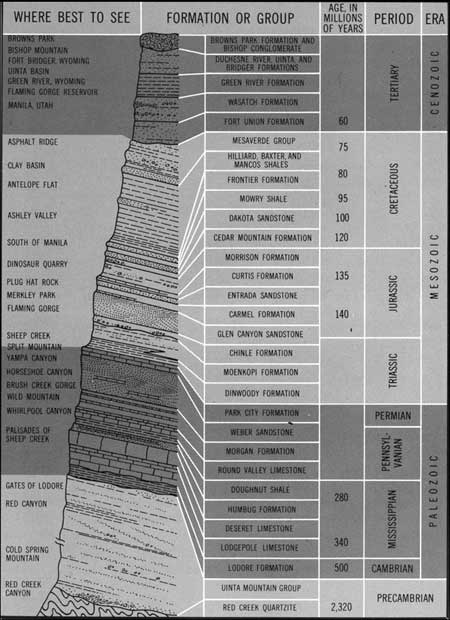
|
Geological Survey Bulletin 1291
The Geologic Story of the Uinta Mountains |
TIME AND THE ROCKS
ONE CAN say little about the Uinta Mountains without talking about rock formations, and, one cannot really understand the structure, history, or development of the range without some knowledge of the rocks. It follows that the better one understands the rocks and how they form, the better one can appreciate the grandeur and beauty of the mountains. The mountains—rising from arid basins north and south and standing starkly bare above timberline in the high interior—are clothed in dense forest only at middle altitudes. Above and below these altitudes, the mountain-sides are mostly bare rock.
To many people, the term "rock formation" is ambiguous. Contrary to much popular misunderstanding, a rock formation is neither an unusual outcrop, nor a strange erosional form, nor a particular proturberance on a given piece of real estate. Rather, a rock formation is a large body of rock that has specific identifying characteristics, such as composition, color, and thickness. It may be of sedimentary, igneous, or metamorphic origin. Two or more formations of similar age or origin are sometimes lumped together as a "group," such as the Uinta Mountain Group and the Mesaverde Group.
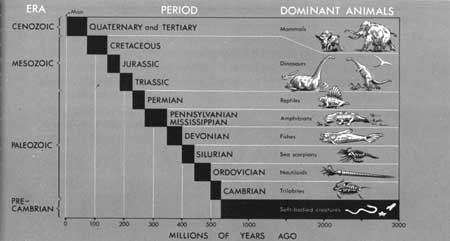
Major divisions of geologic time
A rock formation need not even be exposed at ground surface, but it can and generally does have lateral continuity at depth. Many formations, in fact, extend long distances under cover—that is, they pass beneath hills or basins and reappear only where brought to the surface by uplift or erosion. Some formations that are known almost entirely from drill-hole data are studied intently by specialists looking for clues to the occurrence of petroleum or other mineral resources. Thus, a limestone bed that forms a line of cliffs high in the Uinta Mountains may be penetrated by a drill many miles away and thousands of feet underground in one of the adjoining basins. A geologist might visit the mountains to learn about formations that are deeply buried many miles away. Many rock formations that crop out in the Uinta Mountains are recognized throughout much of the Western Interior of the United States.
Rock formations of the Uinta Mountains range widely in age, composition, and appearance. The oldest are more than 2 billion years old; the youngest are just now being deposited in lakes and streams. Figure 39 shows diagrammatically the sequence of rock formations in the middle and eastern parts of the range. Many particulars are omitted from this chart, and the reader should turn to more technical publications for the details. Moreover, rocks vary appreciably from place to place. Some formations in one part of the range are lacking in other parts. Most of the formations of the Uinta Mountains are sedimentary and were deposited on flat beds as broad blankets of sand, gravel, clay, or limy mud. Solidified, such deposits became sandstone, quartzite, conglomerate, shale, and limestone, with many gradations between. Though they may be only a few hundred or a few thousand feet thick, these formations may extend laterally for hundreds or thousands of square miles.
Travelers crossing the range on Utah State Highway 44 between Vernal and Manila have an excellent opportunity to acquaint themselves with the formations that make up most of the range. From the flanks inward, progressively older rocks are exposed, somewhat like the rings of a tree. Recognizing the unique value of this section, the U.S. Forest Service and the Utah Field House of Natural History have erected markers along the road, identifying each formation in turn.
The same formations, but without labels, are widely exposed elsewhere in the range, at such places as Dinosaur National Monument, Vermilion Creek, and Flaming Gorge, and with much variation along the Weber and Duchesne Rivers. With some training, anyone can quickly identify the major rock units exposed throughout the range. In particular, such units as the Uinta Mountain Group, the Deseret Limestone, the Weber Sandstone, the Glen Canyon Sandstone, the Morrison Formation, and the Dakota Sandstone lend special character and distinction to the Uinta Mountain scene. These units, however, are but half a dozen of more than 30 recognized formations in the Uinta Mountains.
Rocks of the Uinta Mountains are of many ages, ranging from Precambrian to Quaternary. Two distinctive Precambrian formations are present: the older Red Creek Quartzite and the younger Uinta Mountain Group. The Red Creek is confined to a few square miles in the northeastern part of the range, but the Uinta Mountain Group is exposed over many hundreds of square miles, from one end of the range to the other and across the crest from flank to flank. All the high peaks consist of this rock. In brief, its name is well chosen.
Cambrian rocks crop out along the south flank of the range, but they were eroded from the north and northeast flanks before Mississippian time. Ordovician, Silurian, and Devonian rocks are lacking, although rocks doubtfully regarded as Devonian are exposed in a few places. Each subsequent geologic period is represented by one or more rock formations.
The old Uinta trough
Throughout most of recorded geologic time, long before the mountains themselves appeared, the Uinta Mountains region was occupied by a slowly subsiding basin—a broad elongate trough flooded much of the time by shallow-marine waters. This trough was an arm, or embayment, of a great seaway that intermittently covered western North America from Arctic Canada to Mexico. At times the seaway connected the Arctic Ocean to the Gulf of Mexico. Gentle flexing of the earth's crust caused repeated incursions and withdrawls of marine waters. Weight from accumulating sediments that were washed in from the sides of the trough helped cause the sea floor to subside.
The Uinta trough generally subsided more toward the west than toward the east. Marine conditions were therefore more prevalent toward the west, and deposits accumulated more rapidly. As a result, most formations thicken toward the west but thin to the east, north, and south. The present Uinta Mountains, uplifted by mountain-forming movements in the crust 70± million years ago, are relative latecomers to the scene.
Precambrian time
The earliest, most complex sequence of events recorded in the Uinta Mountains took place more than 2 billion years ago, at a time so remote that it boggles the mind. The details of what happened, even though they are incompletely known, are too involved to be reiterated here, but they are described elsewhere (Hansen, 1965, p. 22). In summary, the Red Creek Quartzite was deposited on a well-washed shore. Made up mostly of clean sand, but including some mud and limy mud, it was then compacted, uplifted, folded, metamorphosed, and faulted. Sandstone, shale, and limestone were transformed by heat and pressure deep within the earth into quartzite, mica schist, and marble. Molten igneous rock was then injected into fractures and bedding planes, where it cooled and solidified and, finally, was transformed by renewed heat and pressure into hornblende schist, or amphibolite (fig. 40). New minerals were recrystallized from old, including such showy varieties as actinolite, garnet, kyanite, and staurolite.

|
| CONTORTED RED CREEK QUARTZITE, more than 2 billion years old intruded by dark igneous dike. Exposure is about 100 feet high. (Fig. 40) |
Thus was formed the Red Creek mountain range, long since disappeared. The mountains trended east to west, much like the present Uintas, but, no doubt, they were larger and higher. The age of the mountains, 2.3 billion years, has been determined by radiometric dating—that is, by measuring the decay products of radioactive minerals whose decay rates are known physical constants. Erosion then reduced the Red Creek mountains to their roots—a nearly flat plain on which the Uinta Mountain Group began to accumulate. The base of the Uinta Mountain Group and the roots of the old mountains are well exposed north of Browns Park in a great unconformity visible from the floor of the valley.
When the Uinta Mountain Group began to accumulate, possibly a billion years ago, mountains of Red Creek Quartzite still stood to the northeast not far away. Bouldery alluvial fans spread out into the Uinta trough and formed coarse conglomerates that now are preserved in the Uinta Mountain Group north of Browns Park. The trough subsided slowly, and its rate of subsidence was counterbalanced almost exactly by the accumulation of sediment. No doubt the weight of the sediment was a factor in causing the subsidence. Ripple marks, fossil mud cracks, and even rain prints suggest shallow tidal pools and desiccating mudflats. True marine conditions existed in the western part of the range, where C.A. Wallace has identified an ancient shoreline. At the top of the Uinta Mountain Group, in the western part of the range, a thick shale formation called the Red Pine may have accumulated well offshore. Altogether about 24,000 feet of sandstone, shale, and conglomerate accumulated in the old Uinta trough before gentle uplift ended Precambrian deposition and ushered in the Paleozoic Era.
Paleozoic time: 570-225 million years ago
The Uinta Mountain area once again was an expanse of hills, this time composed of red sandstone, quartzite, and shale. It was exposed to erosion until Middle to Late Cambrian time, when the sea moved in again. The sea encroached from west to east, depositing first the Tintic Quartzite and Ophir Shale at the west end of the range and then, as it spread eastward, depositing the Lodore Formation toward the east. The Lodore, well exposed in Dinosaur National Monument, is a succession of red, gray, and green sandstone and shale containing brachiopods and rare trilobites, primitive little cousins of our modern horseshoe crab. These fossils are the oldest clear evidence of life in the Uinta Mountains.
Cambrian time was followed again by emergence of the land. Just when this happened is uncertain because there is a stratigraphic gap of about 150 million years; Ordovician, Silurian, and probably Devonian rocks are lacking. At any rate, marine Mississippian rocks (Lodgepole Limestone) overlap the eroded edges of the Cambrian in many parts of the range. Along most of the present north flank, Cambrian rocks were completely eroded away before Mississippian time.
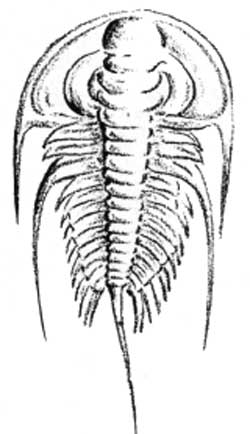
Trilobite, about natural size
The Mississippian Period brought in a reexpansion of the seaway and, with it, widespread deposition of the Madison Limestone and its equivalents. These rocks crop out from Alberta to Arizona, even to Sonora. The famous Redwall of Grand Canyon is the southern correlative. In the Uintas these rocks comprise four formations: the Lodgepole, Deseret, Humbug, and Doughnut. The Mississippian limestones form bold outcrops wherever they are exposed. They form the imposing "gateways" in Blacks Fork, Henrys Fork, Beaver Creek, and Burnt Fork, the "Palisades" of Sheep Creek (fig. 41), the east wall of Irish Canyon, and the giant stairsteps of Whirlpool and Lodore Canyons. Though resistant to erosion, these limestones are highly susceptible to solution by carbonatic waters, and many caverns have formed along their outcrops. Large springs issue from some of them, as at Sheep Creek. At other places whole streams disappear into the ground. Lost Creek, on the north flank near Burnt Fork, is such a stream; it empties into a sinkhole at the base of the Lodgepole Limestone. Dry Fork of Ashley Creek, Pole Creek (a tributary of the Uinta), Brush Creek, and Little Brush Creek all lose drainage into the Mississippian limestone.

|
| PALISADES OF SHEEP CREEK. Eroded edge of upturned Mississippian limestone in contact with the Uinta Mountain Group, left. (Fig. 41) |
In addition to limestone, rocks of Mississippian age in the Uinta Mountains include sandstone and shale. Marine organisms flourished, and their fossilized remains are abundant, especially corals, brachiopods, crinoids, and snails.
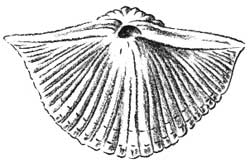
Spirifer, a common late Paleozoic brachiopod, about natural size
Throughout the remainder of Paleozoic time, the restless sea ebbed and flowed. The formations succeeding the Mississippian rocks—the Round Valley, Morgan, Weber, and Park City—all contain marine fossils. Yet, deposition was interrupted from time to time as the sea floor emerged. High mountainous islands stood to the southeast in Colorado and far to the west in Nevada in late Paleozoic time (fig. 42). The Round Valley Limestone was deposited well offshore, and the Morgan Formation was deposited near shore in shallow water of variable depth. The Weber Sandstone is mainly a beach deposit, and some of it may have accumulated as onshore sand dunes. But it also contains fossiliferous marine limestone. Much more could be said about the Weber; it is one of the most impressive and picturesque formations in the entire Uinta Mountains.
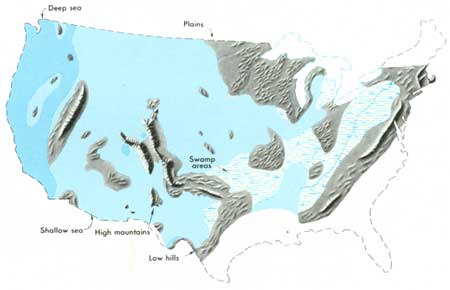
|
| GENERALIZED GEOGRAPHIC MAP of the United States in Middle Pennsylvanian time. (Fig. 42) |
The Park City Formation, on top of the Weber, is varied most of all. It contains a host of rock types laid down under diverse conditions. Deep water lay west of the Uintas; a shoreline lay east. Limestone predominates in most places and makes long resistant hill slopes (fig. 56), but phosphate rock is the most distinctive. It formed by the upwelling of organic-rich marine waters on the margin of a long-vanished continental shelf. These deposits are now being mined in big open pits near Vernal for use in the production of phosphatic fertilizer. The Park City Formation also contains gypsum, sandstone, conglomerate, and mudstone, cherty nodules and geodes, and, locally, many fossils.
Mesozoic time: 225-65 million years ago
The Paleozoic Era drew to a close with clear marine waters still spread across the Uinta Mountains region. Following in Triassic time, environmental conditions continued to change. At first, shallow-marine muds of various shades of gray, red, and green were spread across the region, perhaps in a broad tidal delta, shoaling toward the east (the Woodside, Dinwoody, and Moenkopi Formations). As time passed, the sea floor subsided toward the west, and marine limestones (Thaynes Limestone) again began to accumulate. A few clams and their cousins lived in the Western Uinta region at that time, and countless ammonites teemed in the waters farther west. But in the Eastern Uinta region, gypsum was forming from concentrated sulfate brines in shallow arms of the sea, and few organisms survived. These gypsum beds are in the lower and middle parts of the Moenkopi Formation, laterally equivalent in the eastern part of the range to the Thaynes Limestone in the west. The gypsum is interbedded with ripple-marked red mudstone; together they form a conspicuous pinkish band several hundred feet thick in the Moenkopi north of Vernal and south of Manila (fig. 43).

|
| TRIASSIC ROCKS exposed in Sheep Creek Canyon near Flaming Gorge. Gray Dinwoody Formation (foreground) overlain by Moenkopi, Chinle, and Glen Canyon, forming canyon wall and skyline. (Fig. 43) |
Regional uplift followed deposition of the Moenkopi Formation. Thousands of square miles of eastern and southern Utah, northern Arizona, western Colorado, and southern Wyoming were gently elevated, draining off the sea. No mountains were formed, but much of the Moenkopi was carried away by erosion (fig. 44). The succeeding Chinle and Ankareh Formations (lateral equivalents, in part) began to form first as gravelly river-channel deposits, filling hollows and swales in the eroded top of the Moenkopi, then as a complex assemblage of red, purple, ocher, and green silts, muds, sands, and gravels, augmented by occasional falls of ash from distant volcanoes. Conditions clearly were non-marine; fossil wood and remains of reptiles, amphibians, and mollusks, though uncommon, all suggest a terrestrial, perhaps marshy environment. Utter desiccation then ensued, and the whole Western Interior of the country became a vast desert.
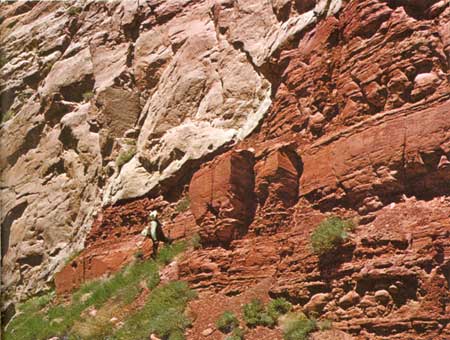
|
| MOENKOPI FORMATION (lower right) leveled by erosion and overlain unconformably by Chinle Formation (upper left). One mile southwest of Flaming Gorge. (Fig. 44) |
The Chinle and Ankareh Formations extend upward into the Glen Canyon Sandstone,3 a thick deposit of pink and gray to orange fossil sand dunes, which advanced across the old Chinle Ankareh landscape.
3The name "Glen Canyon" has been applied recently in the Uinta Mountains to rocks formerly called Nugget or Navajo, a new usage which obviates certain correlation problems with other regions.
The Glen Canyon is one of the prominent cliff-forming units in the Uinta Mountains, and it enhances the local scenery wherever it crops out. Northwest of Vernal it forms the walls of Merkley Park (fig. 45) and the "beehives," arches, and alcoves of Neal Dome. Near Manila the Glen Canyon forms the heights of Jessen Butte, the north wall of Sheep Creek Canyon, the caprocks of Flaming Gorge, and the spine of Dutch John Mountain. Equivalent rocks are widespread in the canyon lands of southern Utah, where, for example, they form the towering walls of Zion and Glen Canyons. Altogether, an immense expanse of dunes covered much of the Western Interior of the country. Though centered in Utah, the dunes extended into Nevada, Arizona, New Mexico, Colorado, Wyoming, and Idaho. The crossbedded internal structure of the Glen Canyon Sandstone, a clear indication of its origin, is well preserved in the solid rock and gives the formation much of its scenic character.
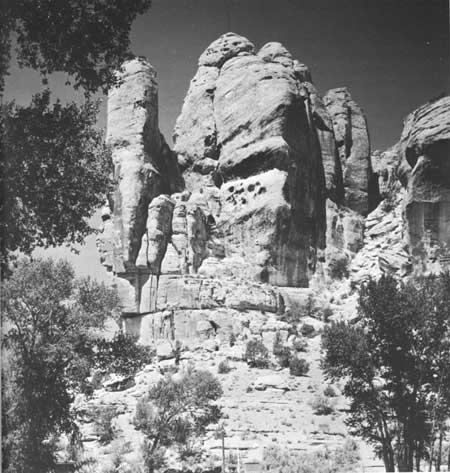
|
| CLIFF-FORMING GLEN CANYON SANDSTONE, overlying the Chinle Formation, at Merkley Park, Vernal, Utah. Photograph by Hal Rumel. (Fig. 45) |
Deposition of the Glen Canyon Sandstone ended when the Interior seaway readvanced across the region, again from the west. The sea bottom deepened to the west, like the earlier pattern of encroachment, and it shoaled to the east. Desert conditions persisted along the shore as the water lapped eastward. Accordingly, thick gray limestones interbedded with gray and red shales west of the Uinta Mountains diminish in thickness and pass gradually eastward into a much thinner section of red, green, and gray mudstone, shale, gypsum, and subordinate limestone. The thick section is called the Twin Creek Limestone. Its thin eastward counterpart is called the Carmel Formation. The Carmel disappears at about Skull Creek near the east end of the Uinta Mountains.
The Twin Creek sea was well populated with shellfish, and their remains are easy to find. Some limestone beds contain abundant fossilized clams, oysters, ammonites, sea urchins, and crinoids. Near Flaming Gorge, shell beds, or "coquinas," consist almost entirely of tightly packed shells and shell fragments. North of Vernal, beautifully preserved fossil clam shells have been replaced—through the process of petrifaction—by reddish-orange jasper. Conditions for the survival of life were unfavorable, however, when or where gypsum and red mud were accumulating in the Carmel Formation; these deposits, of course, contain no fossils.
After the Twin Creek and the Carmel were deposited, the sea withdrew again. Its withdrawal this time was recorded by the Entrada Sandstone. The Entrada consists of clean white to pink cliff-forming sandstone interbedded with red or brown mudstone. The red or brown beds, locally called the Preuss Sandstone, may have accumulated in shallow stagnant water, but the white to pink sandstones were dunes. As the sea withdrew the dunes crowded close against the shore, and as the sea readvanced the dunes pulled back. Mudstone thus predominates toward the west along the mountains, and sandstone, toward the east. In the more easterly sections, the Entrada consists entirely of windblown sand. East of the pinchout of the underlying Carmel Formation, the Entrada and the Glen Canyon combine to form a single thick body of cliff-forming sandstone.
The withdrawal was short lived, for the sea returned again, readvancing far beyond its previous shoreline to central Colorado. Its deposits this time were gray to greenish-gray marine sandstone, shale, and limestone, called the Curtis Formation. (In the Weber River drainage, it is generally called the Stump Sandstone.) The Curtis sea had a diverse fauna. Among the more typical inhabitants was the belemnite, a soft-bodied relative of the squid and cuttlefish, having an internal shell of "cuttlebone," commonly preserved as a fossil. Several kinds of clams, snails, and, locally, ammonites were also abundant. Near Manila, countless little brachiopods left their shells in the uppermost beds of the formation.

Squidlike belemnite, about one-fourth natural size
As the Curtis sea pulled back, nonmarine mud, sand, and gravel from distant sources to the west or south built up a thick alluvial plain, now the Morrison Formation. Frequent falls of volcanic ash must have dimmed the hot Jurassic sun. The Morrison Formation is famed especially for its dinosaurs, nowhere better exemplified than in Dinosaur National Monument. But it also is one of the West's leading uranium producers, though not in the Uinta Mountains. Chief production from the Morrison is in southwestern Colorado and southeastern Utah.
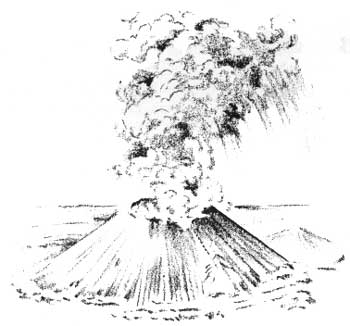
The Morrison Formation is very widespread, and its variegated red, gray, green, and lavender clays are everywhere characteristic. It crops out around mountainous uplifts throughout most of the Rocky Mountain region and passes deep underground in between.
Dinosaur bones from the Uinta Mountains have been known for many years. Powell noted "reptilian remains" during his explorations, and O. A. Peterson of the American Museum of Natural History identified dinosaur bones in 1893. The world famous deposit north of Jensen was discovered in 1909 by Earl Douglass of the Carnegie Museum. Carnegie Museum operated the quarry from that time to 1922. The United States National Museum, the American Museum of Natural History, and the University of Utah operated it in 1923-24. After that time, collecting was discontinued. Assembled specimens are on display in museums at Denver, Lincoln, New York, Pittsburgh, Salt Lake City, Toronto, and Washington. In all, 26 nearly complete skeletons and parts of about 300, representing 10 different species, were recovered before the quarry was shut down (Good and others, 1958). Meateaters as well as vegetarian dinosaurs, large and small, were taken from the quarry. Among the more noteworthy were Diplodocus, about 76 feet long; Apatosaurus, about 70 feet long; and Stegosaurus, about 20 feet long—all vegetarians—and Antrodemus, a bipedal carnivore, about 30 feet long.
Small dinosaurs were collected also, some only the size of chickens. A nearly complete lizardlike adult crocodile found by the Carnegie Museum was only about 7-1/2 inches long. In addition, the quarry has yielded the remains of large crocodiles and of tortoises, fresh-water clams, and plants—surely one of the most extraordinary fossil deposits in the world.
The miracle of fossilization is thus reaffirmed by the dinosaur quarry. The odds against such a deposit being preserved are almost astronomical. The likelihood that the remains of a particular creature will be preserved, especially a land-dwelling animal, is extremely remote. At best, only the hard parts, such as the bones, are apt to be preserved. When, for example, one contemplates the millions of bison that roamed the Great Plains only 100 years ago and the present scarcity of their remains, one can appreciate the odds against fossilization. Of the trillions of organisms that have lived and died on the earth, only the smallest fraction has been left behind as fossils.
Quick burial is essential, to remove the remains from the weather. Bones left to the sun and elements soon disintegrate; wood left lying in the forest soon returns to the soil. Petrifaction then must replace or reinforce the organic tissues with stone—generally silica, molecule by molecule—to forestall destruction during subsequent earth movements or rapid deterioration on reexposure to the elements. Finally, reexposure must be at the right place and at the right time for man to discover the fossils before they are destroyed by weathering and erosion.
Today, the National Park Service is developing the dinosaur quarry as an in-place exhibit. Bones are being carefully uncovered from their stony matrix, but left in place, so that the visitor can see them just as they were deposited (fig. 46). As pointed out by John Good of the National Park Service, the dinosaurs did not all live together in one habitat group, nor did they all die together in some great catastrophe. Their remains probably accumulated one by one on a bar of an ancient river as their dead bodies floated downstream from time to time. Sediment rapidly covered the deposit, protecting the bones from decay. Lithification followed, encasing the bones in solid rock. Mountain-forming uplift and erosion finally exposed the deposit as Douglass found it 130 million years later.
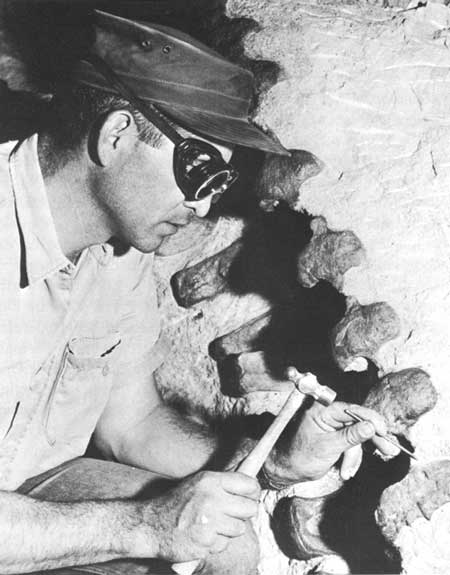
|
| AT THE DINOSAUR QUARRY. A paleontologist carefully chips rock matrix from a column of dinosaur vertebrae. These bones will be left in place for the visitor to see them just as they were deposited. National Park Service photograph. (Fig. 46) |
As the Morrison episode was drawing to a close, events far to the west of the Uinta Mountains were shaping the depositional pattern of the future. High mountains were rising in California, and were soon to rise in Nevada and western Utah, shedding their sediments eastward. The seas, which through much of Paleozoic and Mesozoic time had invaded the region from the west, were pushed to the east; the newly formed lands to the west were never again flooded. Nonmarine Lower Cretaceous rocks accumulated on the Morrison Formation without any clear-cut interruption in deposition. These rocks are called the Cedar Mountain Formation. They have a varied content and variegated color, like the Morrison, but they are characterized especially by soft mudstones in pale-lavender tints. In many places they contain "gastroliths," the so-called gizzard stones of dinosaurs. (Whether or not these were ever actually ingested by dinosaurs is open to question. Authorities do not agree.) The base of the Cedar Mountain is indicated in some places by a pebbly ledge-forming unit called the Buckhorn Conglomerate Member. The Buckhorn is well exposed, for example, just south of Escalante Overlook, along the road from Dinosaur National Monument Headquarters to Harpers Corner, but, where the Buckhorn is lacking, even experts are hard put to find the precise top of the Morrison or the bottom of the Cedar Mountain.

On top of the Cedar Mountain is the Dakota Sandstone. This formation is also very widespread. It extends from Montana to New Mexico and from central Utah to the Great Plains. The Dakota was deposited on the shore of a reexpanding seaway, which encroached this time from the east as part of an inland sea connected to the Gulf of Mexico. As the sea again spread across the shore, sands and gravels accumulated on the beach. The Dakota thus contains marine as well as nonmarine sandstone, conglomerate, and coal-bearing shale that must have accumulated in coastal swamps. Here and there are bits of petrified wood. Many fossil ripple marks and mud cracks indicate intermittent wetting and drying (fig. 47).
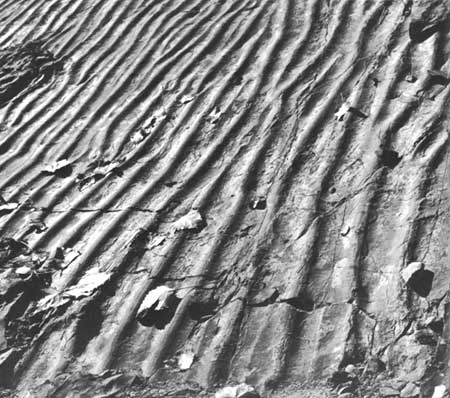
|
| FOSSIL RIPPLE MARKS in the Dakota Sandstone. Together with mud cracks, these features indicate deposition in intermittent shallow water. Photograph by John R. Stacy. (Fig. 47) |
Because it is resistant to erosion, the Dakota Sandstone forms bold outcrops on the flanks of the mountains. Where its dip is gentle, it forms sloping bedrock plains (cuestas) bounded by cliffs facing toward the mountains. Where its dip is steep, it forms narrow rocky ridges (hogbacks) that may extend for miles without a break.
Subsidence of the crust and a flood of ocean water brought Dakota time to a close and introduced the overlying Mowry Shale. This distinctive dark-gray sea-bottom deposit weathers in that direction. Another attribute of the Mowry Shale—a really diagnostic one, and an unmistakable clue to the identity of the formation—is the presence of countless well-preserved fish scales found with very little effort on nearly every outcrop. Powell called the formation the "teleost shale" in allusion to the ill-fated donors of the scales. Perhaps the fish were killed by ash falls. The Mowry sea contained, as well as fish, a few oysters, and at times, some very large ammonites. The largest of these were more than 2 feet across.
At the close of Mowry time, the sea pulled back again, and the bottom temporarily emerged. Then, with a few pulsations back and forth, the sea returned decisively for a long time. During the pulsating phase, the Frontier Formation was deposited. This formation, like the Dakota, consists of beach-laid sandstone, near-shore marine sandstones, and coastal-swamp deposits. Throughout most of the Uinta Mountains the Frontier Formation is twofold: a slope-forming shaly unit below, and a cliff-forming sandstone above. Oysters and other oysterlike shellfish are very characteristic, but the faunal list includes many other mollusks, also, particularly in the shaly lower part of the formation. A coal zone near the top of the shale yielded a few tons of coal in pioneer days, when nearness of supply was more important than the tonnage available. (In other parts of the West, such as Kemmerer, Wyoming, and Coalville, Utah, the Frontier contains large reserves of coal.) The upper sandstone unit of the Frontier, where it is not faulted out or concealed by overlapping rocks, forms a hogback on both flanks of the Uinta Mountains. Travelers on U.S. Highway 40 drive beside it for many miles along the south side of Blue Mountain; at Dinosaur National Monument it crops out just behind Monument Headquarters. The road across Blue Mountain, from Monument Headquarters into Harpers Corner and Echo Park, incidentally, provides excellent views of the whole geologic section of the Eastern Uinta Mountains, from the Frontier Formation down to the Uinta Mountain Group.
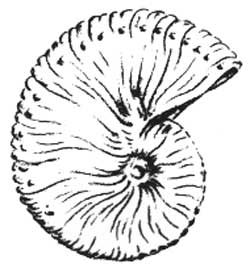
Scaphites, a Cretaceous ammonite, about one-third natural size
As the Frontier Formation accumulated in the Uinta Mountains area, high, newly formed mountains stood not far to the west, perhaps just west of the present Wasatch Range. Inasmuch as these mountains were the source of the sediments, the Frontier Formation thickens enormously in that direction. In the Eastern Uinta Mountains, it is only 100-200 feet thick, but at Coalville, just west of the Uintas, the Frontier is more than 4,400 feet thick and contains coarse conglomerate, as well as sandstone, shale, and coal. A few miles farther west, near Salt Lake City, it is more than 8,700 feet thick.
The Late Cretaceous geography of northeastern Utah can thus be visualized as follows: A broad shallow sea extended eastward from the foot of high north-trending coastal mountains that stood some distance west of the present Uintas (fig. 48). Gravelly alluvial fans reached east from the mountains to the shore. Waves and shore currents constructed sandy beaches and offshore bars. Dense junglelike forests grew down to lagoons behind barrier beaches. The waters teemed with shellfish.
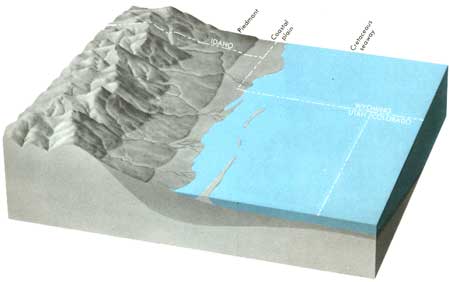
|
| NORTHEASTERN UTAH AND ADJACENT AREAS in Late Cretaceous time. High, newly formed mountains in western Utah shed debris eastward. Coastal-plain deposits accumulated between the mountains and the old Cretaceous seaway, and the crust subsided in the piedmont belt. (Fig. 48) |
The buildup of high mountains to the west perhaps depressed the crust in front of them, for the crust is not rigid, and it responded to the added weight. The sea deepened, and the Frontier Formation thinned eastward, giving way to deep-water clays and muds that later became the Mancos Shale and its equivalents.
The Mancos Shale and its equivalents are very thick deposits of soft, dark-gray shale. They weather into shades of light gray or tan and form dreary badlands on both flanks of the eastern part of the range. On the north flank the names Hilliard and, locally Baxter Shale are used. Though the tops and bottoms are not exactly equivalent, all three units—Mancos, Hilliard, and Baxter—were deposited in the same sea and were once continuous bodies of the same clay.
Where not eroded, the Hilliard, Baxter, and Mancos have a thickness of several thousand feet, a maximum of more than a mile. This is not to say that the water was ever a mile deep. The sea bottom subsided slowly as the mud accumulated, and the crust was depressed beneath it. The shale thins to the west, intertonguing in that direction with sandstones and conglomerates of the thickening Frontier Formation.
Geologic events at this time became very complex throughout western Utah but remained fairly simple in the area that was to become the Uinta Mountains. The Mancos seaway gradually withdrew to the southeast—not however, without many short-lived readvances (fig. 49). Long tongues of beach sand interlayered with coal-bearing coastal swamp deposits marked its retreat and introduced the Mesaverde Group, which overlies and intertongues with the Mancos (fig. 50). Sandstone, shale, and coal comprise the Mesaverde Group, and geologists recognize many distinctive subdivisions. Different names, therefore, have been applied to the Mesaverde in various parts of the West, but for our purposes, the name Mesaverde Group will suffice.

|
| GENERALIZED GEOGRAPHIC MAP of the United States in Late Cretaceous time. (Fig. 49) |
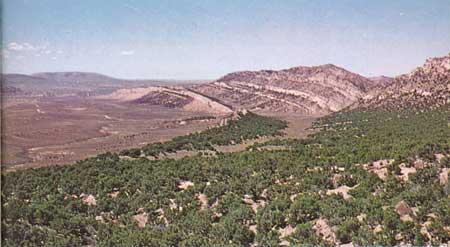
|
| THE GLADES. Hogbacks formed from resistant sandstone of the Mesaverde Group, northeast of Flaming Gorge. Antelope Flat (left) is underlain by soft Hilliard Shale. (Fig. 50) |
By Mesaverde time, the old seaway that had dominated the geography of the Uinta Mountains area since Precambrian time was yielding, finally and irrevocably, to mountain-building forces stirring again to the west. The Mesaverde is the youngest group of rocks that predates uplift of the Uinta Mountains. If anything younger was deposited, it was stripped away by erosion as the mountains began to rise.
The whole Rocky Mountain System was taking shape at about this time. Mountain ranges were forming in response to forces in the earth's crust that were directed horizontally, obliquely, and vertically. Some ranges began to rise before others. At the same time, large basins were forming between the mountain ranges. where the crust buckled down instead of up. Many of these began to fill with water and sediment. Some parts of the crust were stressed to the point of rupture, and they failed by fracturing, or faulting, as great blocks of rock moved past one another, particularly at the flanks of the mountains. Compression dominated in some places, and when it finally slackened, uplifted masses began to subside, in response to gravity. By Cenozoic time, most of the Rocky Mountain ranges and basins as we know them today—not all, but most of them—were well delineated.
Cenozoic time: 65 million years ago to the present
The Tertiary Period and the beginning of the modern day lands
The rise of the Uinta Mountains in Late Cretaceous time was guided by the east-trending old Uinta trough and the thick prism of sediments that had accumulated through the ages. Near the west end of the range, the Evanston Formation, of Late Cretaceous and Paleocene age, contains conglomerate that seems to have been shed from the Uinta Mountains as erosion attacked the newly formed heights. This conglomerate thins toward the west away from the Uinta Mountains, and coarsens toward the east (T. L. Mullens, oral communication, 1968). It contains quartzitic cobbles, moreover, that probably came from the Uintas. Similar conglomerate accumulated in the Currant Creek area near the Duchesne River.
Deposits of latest Cretaceous age are lacking in the Eastern Uinta Mountains and may never have been deposited, but strong uplift and deep erosion plainly had taken place by earliest Tertiary (Paleocene) time. Large-scale faulting had thrust the mountainous core of the range thousands of feet up over the flanks, especially near Flaming Gorge. The Fort Union Formation near Flaming Gorge was deposited across the eroded edges of the older pre-Tertiary formations. Besides carrying the impressions of Paleocene leaves (oak, hickory, sycamore, and others) the Fort Union contains pebbles derived from the new Uinta Mountains to the south, including shale chips that contain fish scales from the Mowry Shale. By this time erosion must have penetrated at least 8,500 feet into the cover of the Uinta arch. By Wasatch time (Eocene) the Eastern Uinta Mountains were breached to their quartzitic core, and a flood of quartzite pebbles, cobbles, and boulders eroded from the Uinta Mountain Group was deposited in alluvial fans at the foot of the mountains. These fans became the Wasatch Formation, a widespread accumulation of sandstone, conglomerate, shale, and limestone in variegated shades of red and gray. North of Manila, the Wasatch contains enormous boulders of Paleozoic limestone—some 8 feet or more across—that were carried off the mountains by Tertiary flash floods or mudflows.
Meanwhile, as the mountains rose and faulting continued, the adjacent basins subsided. Large fresh-water lakes formed to the north and south, filling the basins and lapping against the mountains. The complex history of these lakes—a story in itself—cannot be told here. It has been studied intensively by many geologists, most particularly by W. H. Bradley (1948, 1964). In aggregate, the lake deposits are called the Green River Formation, famous for its vast reserves of oil shale, its enormously large deposits of sodium salts (trona beds), and its remarkably well-preserved fossils. The accumulations of limy muds on the lake bottoms proved to be an ideal medium for the preservation of fossils. Fish remains from the Green River Formation have become world famous, not only for their excellent preservation (fig. 51), but also for their abundance. They are displayed in museums throughout the world. In addition, wonderful impressions of leaves, flowers, fruits, and insects, a feather, and even the remains of a bat, have all been collected from the Green River Formation.
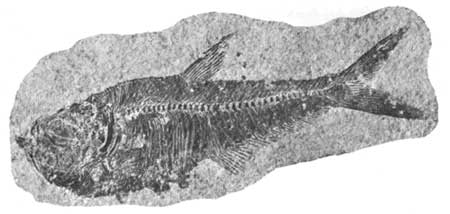
|
| A WELL-PRESERVED EOCENE FISH, Diplomystus dentatus, collected from the Green River Formation. About one-third natural size. Photograph by W. T. Lee. (Fig. 51) |
Most lakes are relatively short-lived geologic features. They are filled to overflowing with sediment; they are drained dry by erosion at their outlets; or their basins are destroyed by crustal warping. The Green River lakes were no exception. They varied greatly in extent and depth from time to time. Saline phases occurred when lake levels dropped below their outlets. At high stages, overflow around the east end of the mountains, according to Bradley, may have joined the Green River Basin to the Uinta. Inevitably, as deltal and alluvial deposits encroached upon the basins, the lakes finally disappeared. They were succeeded by the Bridger and Uinta Formations, north and south. These formations—soft mudstone and sandstone mixed with volcanic ash (fig. 52)—attracted the attention of early-day collectors for their rich faunas of Eocene mammals and reptiles, including the bizarre many-horned Uintatherium. Another formation in the Western Uinta Basin, the Duchesne River Formation, also contains remains of early Tertiary reptiles and primitive mammals.
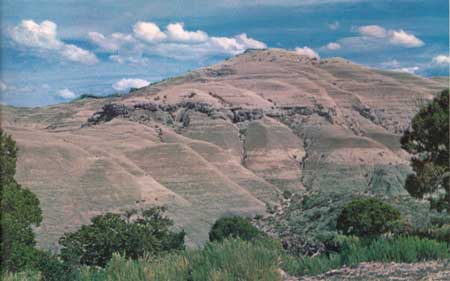
|
| THE BRIDGER FORMATION, typically exposed in badlands southeast of Fort Bridger, Wyoming (Fig. 52) |
By Oligocene time the Uinta Mountain scene was beginning to have a fairly modern appearance. The present divide probably had taken shape. Broad sloping plains (pediments) were forming on the flanks. An apron of coarse gravel, the Bishop Conglomerate (of uncertain age but either Oligocene or Miocene), was accumulating at the outer margin of the plains. Thick remnants of this conglomerate still cap high mesas along the edge of the mountains. Large-scale faulting, propelled by gravity, was beginning in the eastern part of the range, dropping the eastern crest relative to the flanks. The Browns Park Formation was beginning to accumulate; this, perhaps, in Miocene time.
The stage was now set for the sequence of events that shaped the present scene—the development of modern drainage across the mountains, the cutting of the great river canyons, and the glacial sculpture of the high peaks—events already discussed in the section on landscapes. All these events helped mold the Uinta Mountains as we know them today. All past geologic events, in fact, helped shape the present landscape, even the deposition of the Red Creek Quartzite more than 2 billion years ago. Clearly, the landscape, the rocks, and the processes that formed them both are not entities unto themselves. They are interdependent parts of an integrated whole, a continuum of matter, space, and time.

Uintatherium, about 5 feet tall
| <<< Previous | <<< Contents >>> | Next >>> |
bul/1291/sec3.htm
Last Updated: 18-Jan-2007
